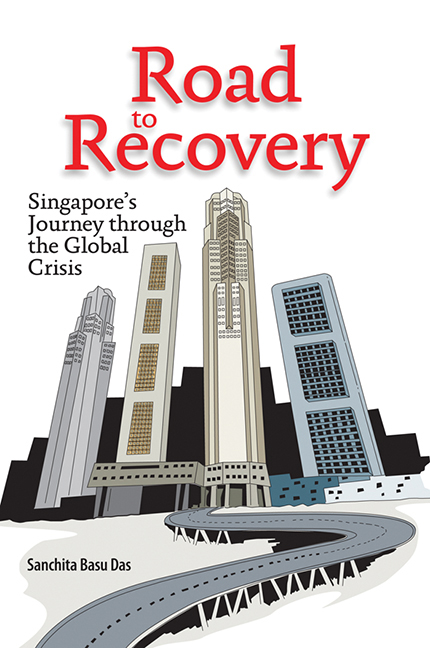Book contents
- Frontmatter
- Dedication
- Contents
- List of Tables
- List of Figures
- List of Boxes
- Foreword
- Acknowledgements
- Abbreviations
- 1 Introduction
- 2 Global Financial and Economic Crisis: Causes, Impact, and Policy Response
- 3 Impact of Global Economic Crisis on Singapore
- 4 Singapore's Policy Responses to the Global Economic Crisis
- 5 Singapore Economic Perspective and Future Policy Directions
- 6 Lessons Learnt
- Appendix I MAS Monetary Policy Statements
- Appendix II Key Budget FY2009 Initiatives
- Appendix III Summary of the ESC Key Recommendations
- Appendix IV Key Budget FY2010 Initiatives
- References
- Index
- About the Author
Appendix IV - Key Budget FY2010 Initiatives
Published online by Cambridge University Press: 21 October 2015
- Frontmatter
- Dedication
- Contents
- List of Tables
- List of Figures
- List of Boxes
- Foreword
- Acknowledgements
- Abbreviations
- 1 Introduction
- 2 Global Financial and Economic Crisis: Causes, Impact, and Policy Response
- 3 Impact of Global Economic Crisis on Singapore
- 4 Singapore's Policy Responses to the Global Economic Crisis
- 5 Singapore Economic Perspective and Future Policy Directions
- 6 Lessons Learnt
- Appendix I MAS Monetary Policy Statements
- Appendix II Key Budget FY2009 Initiatives
- Appendix III Summary of the ESC Key Recommendations
- Appendix IV Key Budget FY2010 Initiatives
- References
- Index
- About the Author
Summary
Benefits for Businesses
Raising Productivity: Skills, Innovation and Economic Restructuring
The Government will commit SG$1.1 billion a year over the next five years in the form of tax benefits, grants and training subsidies to support the national effort to raise productivity.
Details of the relevant Budget measures are given below.
(A) Boosting Skills and Enterprise Productivity through National Effort
(A1) National Productivity and Continuing Education Council (New)
The Government will establish a high-level National Productivity and Continuing Education Council. The Council will be chaired by DPM Teo Chee Hean and include members from the Government, business community and the labour movement. It will:
• Galvanise the major national effort to boost skills and enterprise productivity;
• Develop a comprehensive system for continuing education and training (CET); and
• Oversee the work of the different government agencies and promote close collaboration among the business sector, workers and unions, and the public sector.
More details on the composition of the Council and how it will approach its work will be announced later by DPM Teo.
(B) Investing in People
(B1) Expansion of the Continuing Education and Training (CET) System (Enhanced)
The Government will spend SG$2.5 billion over the next five years on CET.
The Government will build up an outstanding CET system for adults, to complement a first-rate education system for our young. This is our response to the next phase of gains in productivity, which will require us to develop competence in more complex tasks, mastery of skills and depth of expertise in every trade and profession.
(B2) Introduction of Workfare Training Scheme (WTS) (New)
The Government will introduce a three-year Workfare Training Scheme (WTS) to complement the Workfare Income Supplement (WIS) scheme. The WTS will:
• Subsidise 90 per cent to 95 per cent of absentee payroll and course fee outlay for employers, when they send their low-wage workers for training;
• Provide cash grants, capped at SG$400 per year, when WIS recipients complete their training;
• Introduce a structured training programme for those with very low skills, including those who are unemployed.
- Type
- Chapter
- Information
- Road to RecoverySingapore's Journey through the Global Crisis, pp. 190 - 216Publisher: ISEAS–Yusof Ishak InstitutePrint publication year: 2010

